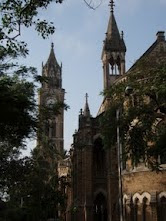There are areas where you have the feeling of being in England. With its green areas, you'll recognize that Bombay was a British colony with its stately buildings and their London's taxis (but sixties version ;)).

The Hindu influence is felt in the temples and in all Hinduism rituals that are done every day.

The Muslim influence, walking through neighborhoods where men are the majority, and women still scarce (and when they appear, most of them with its full burka). On Sundays their children get to play cricket in the streets fantasizing go far one day.

One of Mumbai's attraction is its mix of religions, although most of the population is Hindu or Muslim, notes (vs. other locations) the overrepresentation of minorities: you'll find Buddhism, Christianity, Jainism, Judaism, Parsis and Sikhs, and other unknown to me practiced every day in the slums.


One amazing photo of the quantity and mix of cultures you'll find in the same metropolis, is that about 200 languages and dialects are spoken in Mumbay. Awesome! Walk in the streets is like to feel in a NY parade observing the different costumes people are wearing: the sari, the burka, the most fashionable Louis Vuitton look, the hijab, the clothes you've found yourself… certainly, colors and variety does not lack there :)
As for its buildings: as you can find the famous station (UNESCO World Heritage Site) Chhatrapati Shivaji, you will find also the luxurious and famous hotel Taj Mahal, where the wealthiest of Bombay come at night to take their luxury drinks, with air conditioning, trendy music, and like you were in the highest spheres of NY (actually, I, with my sneakers and my trekking pants, as much as I fix, I feel as "not suitable" for the local, Vs the maked-up beautiful local girls with their heels and trendy dresses from prestigious international brands). This chic atmosphere contrasts with the slum neighborhood that the hotel itself has just around the corner, where there are lack of water, food and schools.

In fact, from an NGO we visited ("Sonrisas de Bombay" - Mumbai's smiles-) told us that only poor people are walking throughout the streets in Bombay. Those who can afford it, will always drive, and never will "mix" with other pedestrians that only have the choose to walk ...
Concerning how I love to walk through my city...
As for beliefs, they are still around: In the slums is hard to evolve as many of curative treatments go against their religions. For example, we visited a leprosy center (thanks to the NGO "Sonrisas de Bombay") in which the owner told us that when trying to medicate patients of leprosy in the slums, they were astonished and thought that the devil had taken his body because his urine was red and his skin turned reddish (effects from the medication), so it was hard to make them understand that it was not the devil, but the cure of their disease.
Concerning how I love to walk through my city...
As for beliefs, they are still around: In the slums is hard to evolve as many of curative treatments go against their religions. For example, we visited a leprosy center (thanks to the NGO "Sonrisas de Bombay") in which the owner told us that when trying to medicate patients of leprosy in the slums, they were astonished and thought that the devil had taken his body because his urine was red and his skin turned reddish (effects from the medication), so it was hard to make them understand that it was not the devil, but the cure of their disease.
Sharing this background, also abound economists, big multinationals growing up every day, and leading-edge technology.
Well sure, in Bombay you'll find everything: joy, sadness, tradition, modernity, fears, innovations, music and dances, disasters, luxuries, colors and … so many aromas to discover!
Well sure, in Bombay you'll find everything: joy, sadness, tradition, modernity, fears, innovations, music and dances, disasters, luxuries, colors and … so many aromas to discover!



















